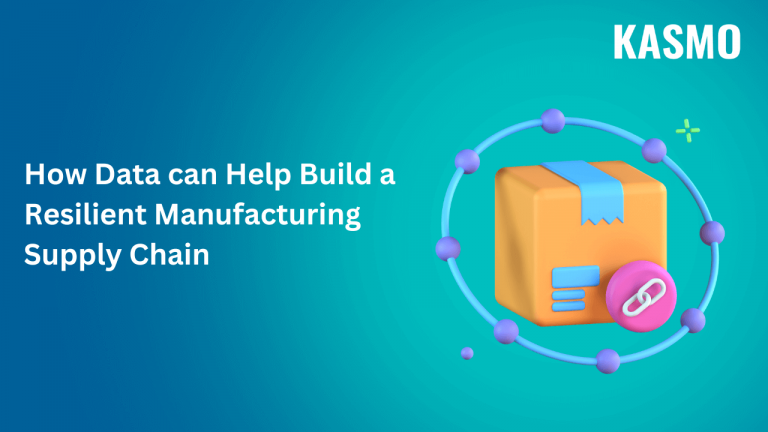The COVID-19 pandemic was an eye-opener for several manufacturers as they grappled with sudden demand fluctuation, exposing critical gaps in their supply chains. According to Accenture, 81% of supply chain leaders said that the pandemic has been their organization’s greatest stress test. While some of these disruptions were uncontrollable, this has underpinned the need to invest in and foster manufacturing supply chain resilience.
Today, manufacturing companies face challenges in every link of the supply chain- starting from planning and sourcing decisions to order management and sales bottle. Manufacturers that are overcoming these roadblocks and thriving share at least one thing in common – they realize the value of a data driven approach and are investing into leveraging it. Data is vital to creating resilience while increasing visibility and agility of supply chains. With data, manufacturers gain a 360-degree view of their supply chain, can promptly identify supply chain risks and fix bottlenecks.
Decoding the Role of Data in Enhancing Manufacturing Supply Chain Resilience
Manufacturing supply chains are complex, so getting end-to-end visibility and flexibility is a complex process. Here are ways in which data can ease this hurdle –
-
Transparent and full visibility into the supply chain
For manufacturers to achieve supply chain resilience it is more important than ever before to ensure seamless information flow as much as operational flows. Demand and supply constraints are highly volatile. As such, getting access to the right sets of supply chain data in real-time is critical to undertake proactive measures to manage uncertainties. When manufacturers have access to reliable data, they can expand their planning horizon for upstream supply chain disruptions. According to McKinsey, “companies with real-time visibility have been able to react to the [COVID-19 pandemic] disruption much more quickly, make fact-based decisions, and minimize the negative impact on their supply chains— or even gain a competitive advantage.
How can manufacturers achieve this?
To enable supply chain visibility and enhance resilience, manufacturing organizations must move out of the siloed mindset when it comes to managing data across multiple systems and databases. Disconnected datasets and lack of coordination between internal teams could hamper information flow and ultimately impact planning and decision-making. A centralized database to store and manage information across the manufacturing value chain is a solution.
-
Smarter Planning and decision-making
Most of the successful manufacturing businesses use real-time data to be proactive rather than reactive to spot bottlenecks and take corrective measures. Once data transparency is achieved across the supply chain, the next step involves analyzing this data to garner deeper insights that aid in informed decision-making. Advanced analytics can be used to break down data into granular insights that can be used to predict demand, optimize inventory and production levels, streamline logistics and ensure seamless order fulfillment. According to a recent report by EY – Many organizations are building advanced analytics to do dynamic SKU rationalization rather than doing one off spreadsheet exercises when inventory gets too high, or the next crisis requires optimization.
How can manufacturers achieve this?
Accurate and coherent data must be fed into algorithms to derive value from it. This refers not only to first party data but also data derived from second (suppliers, logistics partners, and distributors) and third parties (market statistics, supplier inventories, and customer insights). It is comparatively easier to access first and second party data, collecting and updating third party data can be challenging. In a 2021 McKinsey survey of senior supply chain executives, just under half said they understood the location of their tier-one suppliers and the key risks those suppliers face. But only 2 percent could make the same claim about suppliers in the third tier and beyond. That matters because most disruptions originate in these deeper supply chain tiers. Manufacturers must identify ways to integrate accurate second and third-party data into their systems to make more reliable decisions.
3) Channel partner collaboration
Horizontal connectivity and data sharing among channel partners and end customers is often complex, time-consuming and risky. Data generated through this network can be used by manufacturing companies to enhance supply chain efficiency. Real-time data can also be used to monitor supplier performance and reduce any volatility that may arise. The data generated through the channel partner network can be further leveraged for dynamic rerouting, estimating warehouse and supplier proximity, automatic stock relocation, and production and distribution scheduling.
How can manufacturers achieve this?
Manufacturers are constantly exposed to challenges including raw material shortages, logistics constraints, supply-demand fluctuations, and dynamic consumer trends. Visibility into partner network’s supply chain and sharing data with one another promotes optimal resource allocation, enhanced forecasting of demand and purchasing trends, and reduced instances of stockouts or excess and increases supply chain resilience to other unforeseen events.
It is evident that manufacturing success lies largely in achieving supply chain efficiency and resilience. Most companies have only partly addressed the supply chain challenges exposed by the COVID-19 pandemic. Gaining complete visibility into the network and integrating data from multiple sources to make proactive decisions are key challenges that many in the sector are still grappling with. Manufacturers that find a way to effectively leverage data to improve processes and build resilience will steer clear of supply chain shocks and thrive in the long run.
Explore how you can unleash supply chain efficiency with your data, get in touch with our data and analytics experts


